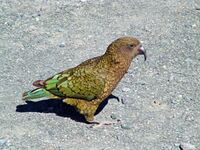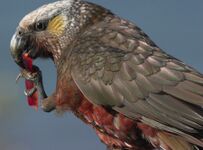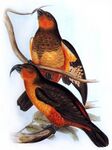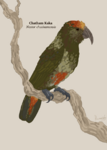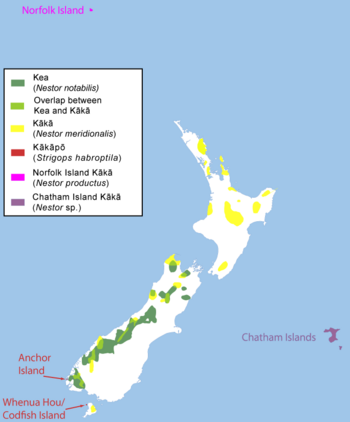Biology:Nestor (genus)
| Nestor | |
|---|---|
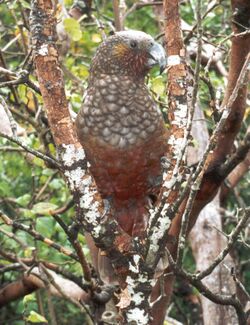
| |
| New Zealand kaka (Nestor meridionalis) | |
| Scientific classification | |
| Domain: | Eukaryota |
| Kingdom: | Animalia |
| Phylum: | Chordata |
| Class: | Aves |
| Order: | Psittaciformes |
| Family: | Strigopidae |
| Genus: | Nestor Lesson, 1830 |
| Type species | |
| Psittacus nestor[1] Latham, 1790
| |
| Species | |
|
N. notabilis Kea | |
The genus Nestor is one of the two extant genera of the parrot family Strigopidae.[2] Together with the kākāpō, and the extinct parrots in the genus Nelepsittacus, they form the parrot superfamily Strigopoidea. The Nestor's genus contains two extant parrot species from New Zealand and two extinct species from Norfolk Island, Australia and Chatham Island, New Zealand, respectively. All species are large stocky birds with short squarish tails. A defining characteristic of the genus is the tongue, which is tipped with a hair-like fringe.[3] The superficial resemblance of this tongue to that of lorikeets has led some taxonomists to consider the two groups closely related, but DNA evidence shows they are not.[4][5]
Classification
All four species in the genus Nestor are thought to stem from a 'proto-kaka', dwelling in the forests of New Zealand 5 million years ago.[4][6] The closest living relative of the genus is the kākāpō (Strigops habroptilus).[4][6][7][8] Together, they form the Strigopoidea, an ancient group that split off from all other Psittaciformes before their radiation.[4][6][8]
In 2012 Leo Joseph and collaborators proposed that the genus Nestor should be placed in its own family, Nestoridae.[9] This proposal has not been adopted in lists of the world birds and instead Nestor is placed with the genus Strigops in the family Strigopidae.[10][11][12][13]
Species
There are two surviving species and at least one well documented extinct species in the genus Nestor. Very little is known about the fourth, the Chatham kākā, which may have been conspecific with another kaka species.
- Kea, Nestor notabilis
- Kākā, Nestor meridionalis
- North Island kākā, Nestor meridionalis septentrionalis
- South Island kākā, Nestor meridionalis meridionalis
- †Norfolk kākā, Nestor productus (extinct)
- †Chatham kākā, Nestor chathamensis (extinct)
| Nestoridae | |||
|---|---|---|---|
| Common name (binomial name) status |
Image | Description | Range and habitat |
| Kea (Nestor notabilis) |
48 cm (19 in) long. Mostly olive-green with scarlet underwings and rump. Dark-edged feathers. Dark brown beak, iris, legs, and feet. Male has longer bill.[15] | New Zealand: South Island High-level forests and subalpine scrublands 850–1400 m AMSL.[16] | |
| South Island kākā (Nestor meridionalis meridionalis) |
Similar to the North Island kaka, but slightly smaller, brighter colours, the crown is almost white, and the bill is longer and more arched in males.[18] | New Zealand: South Island Unbroken tracts of Nothofagus and Podocarpus forests 450–850 m AMSL in summer and 0–550 m in winter.[16] | |
| North Island kākā (Nestor meridionalis septentrionalis) |
About 45 cm (18 in) long. Mainly olive-brown with dark feather edges. Crimson underwings, rump, and collar. The cheeks are golden/brown. The crown is greyish.[18] | New Zealand: North Island Unbroken tracts of Nothofagus and Podocarpus forests between 450–850 m AMSL in summer and 0–550 m in winter.[16] | |
| Norfolk kākā |
About 38 cm long. Mostly olive-brown upperparts, (reddish-)orange cheeks and throat, straw-coloured breast, thighs, rump and lower abdomen dark orange.[3] | Formerly endemic on Norfolk Island and the adjacent Phillip Island[20] Rocks and trees[3] | |
| Chatham kākā (†Nestor chathamensis) |
Only known from subfossil bones.[21] | Formerly endemic on Chatham Island of New Zealand Forests[21] | |
Status
Of the four species, the Norfolk kaka[19][20] and Chatham kaka[21] became extinct in recent history. The last known individual of the Norfolk kaka died in captivity in London sometime after 1851,[22] and only between seven[23] and 20[24] skins survive. The Chatham kaka became extinct in pre-European times, after Polynesians arrived at the island, between 1550 and 1700, and is only known from subfossil bones.[21] The mainland kaka is listed as endangered,[17][18] and the kea is listed as vulnerable.[14][15]
References
| Wikisource has the text of a 1911 Encyclopædia Britannica article about Nestor. |
- ↑ "Psittacidae". The Trust for Avian Systematics. https://www.aviansystematics.org/4th-edition-checklist?viewfamilies=67.
- ↑ Joseph, Leo (2012). "A revised nomenclature and classification for family-group taxa of parrots (Psittaciformes)". Zootaxa 3205: 26–40. doi:10.11646/zootaxa.3205.1.2. http://www.mapress.com/zootaxa/2012/f/z03205p040f.pdf.
- ↑ 3.0 3.1 3.2 Forshaw, Joseph M.; Cooper, William T. (1981). Parrots of the World (corrected second ed.). David & Charles, Newton Abbot, London. ISBN 0-7153-7698-5.
- ↑ 4.0 4.1 4.2 4.3 Wright, T.F.; Schirtzinger, E. E.; Matsumoto, T.; Eberhard, J. R.; Graves, G. R.; Sanchez, J. J.; Capelli, S.; Muller, H. et al. (2008). "A Multilocus Molecular Phylogeny of the Parrots (Psittaciformes): Support for a Gondwanan Origin during the Cretaceous". Mol Biol Evol 25 (10): 2141–2156. doi:10.1093/molbev/msn160. PMID 18653733.
- ↑ Tokita, M; Kiyoshi, T; Armstrong, KN (2007). "Evolution of craniofacial novelty in parrots through developmental modularity and heterochrony.". Evolution & Development 9 (6): 590–601. doi:10.1111/j.1525-142X.2007.00199.x. PMID 17976055.
- ↑ 6.0 6.1 6.2 Grant-Mackie, E.J.; Grant-Mackie, J.A.; Boon, W.M.; Chambers, G.K. (2003). "Evolution of New Zealand Parrots". NZ Science Teacher 103.
- ↑ Juniper, Tony; Mike Parr (1998). Parrots: A Guide to Parrots of the World. Yale University Press. ISBN 978-0-300-07453-6.
- ↑ 8.0 8.1 de Kloet, R.S.; de Kloet, S.R. (2005). The evolution of the spindlin gene in birds: sequence analysis of an intron of the spindlin W and Z gene reveals four major divisions of the Psittaciformes. Molecular Phylogenetics and Evolution 36: 706–721.
- ↑ Joseph, L.; Toon, A.; Schirtzinger, E.E.; Wright, T.F.; Schodde, R. (2012). "A revised nomenclature and classification for family-group taxa of parrots (Psittaciformes)". Zootaxa 3205 (1): 26–40. doi:10.11646/zootaxa.3205.1.2.
- ↑ Gill, Frank; Donsker, David; Rasmussen, Pamela, eds (January 2023). "Parrots, cockatoos". IOC World Bird List Version 13.1. International Ornithologists' Union. https://www.worldbirdnames.org/bow/parrots/.
- ↑ The Howard & Moore Complete Checklist of the Birds of the World. 1: Non-passerines (4th ed.). Eastbourne, UK: Aves Press. 2013. p. 353. ISBN 978-0-9568611-0-8. https://archive.org/details/howardmoorecompl0001howa/page/353/mode/1up.
- ↑ Clements, J.F.; Schulenberg, T.S.; Iliff, M.J.; Fredericks, T.A.; Gerbracht, J.A.; Lepage, D.; Billerman, S.M.; Sullivan, B.L. et al. (2022). "The eBird/Clements Checklist of Birds of the World: v2022". http://www.birds.cornell.edu/clementschecklist.
- ↑ "HBW and BirdLife Taxonomic Checklist v7". Birdlife International. http://datazone.birdlife.org/species/taxonomy.
- ↑ 14.0 14.1 BirdLife International (2017). "Nestor notabilis". IUCN Red List of Threatened Species 2017: e.T22684831A119243358. doi:10.2305/IUCN.UK.2017-3.RLTS.T22684831A119243358.en. https://www.iucnredlist.org/species/22684831/119243358. Retrieved 12 November 2021. Database entry includes a range map and justification for why this species is endangered.
- ↑ 15.0 15.1 "Kea - BirdLife Species Factsheet". BirdLife International. 2008. http://www.birdlife.org/datazone/species/index.html?action=SpcHTMDetails.asp&sid=1410&m=0.
- ↑ 16.0 16.1 16.2 Juniper, Tony; Mike Parr (1998). Parrots: A Guide to Parrots of the World. Yale University Press. ISBN 978-0300074536.
- ↑ 17.0 17.1 17.2 BirdLife International (2016). "Nestor meridionalis". IUCN Red List of Threatened Species 2016: e.T22684840A93049267. doi:10.2305/IUCN.UK.2016-3.RLTS.T22684840A93049267.en. https://www.iucnredlist.org/species/22684840/93049267. Retrieved 12 November 2021. Database entry includes a range map and justification for why this species is endangered.
- ↑ 18.0 18.1 18.2 "Kaka - BirdLife Species Factsheet". BirdLife International. 2008. http://www.birdlife.org/datazone/species/index.html?action=SpcHTMDetails.asp&sid=1412&m=0.
- ↑ 19.0 19.1 BirdLife International (2016). "Nestor productus". IUCN Red List of Threatened Species 2016: e.T22684834A93049105. doi:10.2305/IUCN.UK.2016-3.RLTS.T22684834A93049105.en. https://www.iucnredlist.org/species/22684834/93049105. Retrieved 12 November 2021. Database entry includes a range map and justification for why this species is endangered.
- ↑ 20.0 20.1 "Norfolk Island Kaka - BirdLife Species Factsheet". BirdLife International. 2008. http://www.birdlife.org/datazone/species/index.html?action=SpcHTMDetails.asp&sid=1411&m=0.
- ↑ 21.0 21.1 21.2 21.3 21.4 Millener, P. R. (1999). "The history of the Chatham Islands' bird fauna of the last 7000 years – a chronicle of change and extinction. Proceedings of the 4th International meeting of the Society of Avian Paleontology and Evolution (Washington, D.C., June 1996).". Smithsonian Contributions to Paleobiology 89: 85–109. http://www.sil.si.edu/smithsoniancontributions/Paleobiology/sc_RecordSingle.cfm?filename=SCtP-0089.
- ↑ Greenway, James Cowan (1967). Extinct and Vanishing Birds of the World (2nd ed.). New York: Dover Publications.
- ↑ "Nestor productus - Norfolk Island Kaka specimen(s) in the ZMA". Nlbif.eti.uva.nl. http://nlbif.eti.uva.nl/zma3d/detail.php?id=226&sort=taxon&type=all.
- ↑ "Naturalis - Extinct bird: Nestor productus (Norfolk Island Kaka)". Nlbif.eti.uva.nl. http://nlbif.eti.uva.nl/naturalis/detail?lang=uk&id=51.
Wikidata ☰ Q508474 entry
 |
